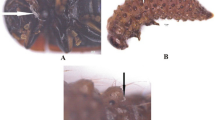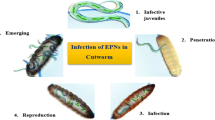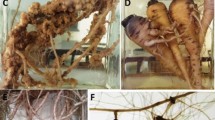Abstract
The common guava, yellow guava, or lemon guava, Psidium guajava L. (Myrtaceae), is native to the Americas and widely cultivated in more than 50 tropical and subtropical countries. There are many insect pests that limit guava production. Biological control should be considered to avoid extensive use of insecticides. Entomopathogenic nematodes can be very effective against life stages in the soil. Therefore, this review aims to summarize most studies carried out for control of guava pests by entomopathogenic nematodes.
Similar content being viewed by others
References
Almeida JEM, Batista Filho A, Oliveira FC, Raga A (2007) Pathogenicity of the entomopathogenic fungi and nematode on Medfly, Ceratitis capitata (Wied.) (Diptera: Tephritidae). BioAssay 2:1–7
Aluja M (1994) Bionomics and management of Anastrepha. Annu Rev Entomol 39:155–178
Aluja M, Guillen J, Liedo P, Cabrera M, Rios E, de la Rosa G, Celedonio H, Mota D (1990) Fruit infesting Tephritids (Dipt.: Tephritidae) and associated parasitoids in Chiapas, Mexico. Entomophaga 35(1):39–48
Bailez OE, Viana-Bailez AM, Lima JOG, Moreira DDO (2003) Life-history of the guava weevil, Conotrachelus psidii Marshall (Coleoptera: Curculionidae), under laboratory conditions. Neotrop Entomol 32:203–207
Barbosa-Negrisoli CR, Garcia MS, Dolinski C, Negrisoli AS Jr, Bernardi D, Nava DE (2009) Efficacy of indigenous entomopathogenic nematodes (Rhabditida: Heterorhabditidae, Steinernematidae), from Rio Grande do Sul Brazil, against Anastrepha fraterculus (Wied.) (Diptera: Tephritidae) in peach orchards. J Invertebr Pathol 102:6–13
Beaver JB, Calkins CO (1984) Susceptibility of Anastrepha suspense (Diptera: Tephritidae) to sterneinernematid and heterorhabditid nematodes in laboratory studies. Environ Entomol 13:137–139
Birke A, Aluja M (2011) Anastrepha ludens and Anastrepha serpentina (Diptera: Tephritidae) do not infest Psidium guajava (Myrtaceae), but Anastrepha obliqua occasionally shares this resource with Anastrepha striata in nature. J Econ Entomol 104(4):1204–1211
Boscán de Martinez N, Cásares R (1980) El gorgojo de la guayaba Conotrachelus psidii Marshal (Coleptera: Curculionidae). I. Evaluacion de daños. Agron Trop 30:77–83
Boscán de Martinez N, Cásares R (1982) Distribuition em el tiempo de las fases del gorgojo de la guayaba Conotrachelus psidii Marshall (Coleoptera: Curculionidae) em el campo. Agron Trop 31:123–130
CABI (2015) In: Invasive species compendium. http://www.cabi.org/isc/datasheet/5654. Accessed May 2015
Canal NA, Alvarenga CD, Zucchi RA (1998) Níveis de infestação de goiaba por Anastrepha zenildae Zucchi (Diptera: Tephritidae), em pomares comerciais do norte de Minas Gerais. An Soc Entomol Brasil 27(4):657–661
Coperland RS, Wharton RA, Luke Q, de Meyer M, Lux S, Zenz N, Machera P, Okumu M (2006) Geographic distribution, host fruit, and parasitoids of African fruit fly pests Ceratitis anonae, Ceratitis cosyra, Ceratitis fasciventris, and Ceratitis rosa (Diptera: Tephritidae) in Kenya. Ann Entomol Soc Am 99(2):261–278
Danjuma S, Boonrotpong S, Thaochan N, Permkam S, Satasook C (2013) Biodiversity of the genus Bactrocera (Diptera: Tephritidae) in guava Psidium guajava L. orchards in different agro-forested locations of southern Thailand. Int J Chem Environ Biol Sci (IJCEBS) 1(1):538–544
Del Valle EE, Dolinski C, Barreto ELS, Souza RM, Samuels RI (2008) Efficacy of Heterorhabditis baujardi LPP7 (Nematoda: Rhabditida) applied in Galleria mellonella (Lepidoptera: Pyralidae) insect cadavers to Conotrachelus psidii, (Coleoptera: Curculionidae) larvae. Biocontrol Sci Technol 18:33–41
Delgado-Ochica Y, Aponte AS (2012) Virulencia, producción y desplazamiento de nematodos entomopatógenos sobre larvas del picudo de la guayaba, Conotrachelus psidii Marshall (Coleoptera: Curculionidae) en laboratorio. Univ Sci 17(3):283–290
Dolinski C, Del Valle EE, Stuart RJ (2006) Virulence of entomopathogenic nematodes to larvae of guava weevil, Conotrachelus psidii (Coleoptera: Curculionidae), in laboratory and greenhouse experiments. Biol Control 38:422–427
Dowds BCA, Peters A (2002) Virulence mechanisms. In: Gaugler R (ed) Entomopathogenic nematology. CABI Publishing, New York, pp 79–98
EPPO (2014) In: PQR database. EPPO plant quarantine data retrieval system. European and Mediterranean plant protection organization. http://www.eppo.int/DATABASES/pqr/pqr.htm. Accessed May 2015
Ferron P (1985) Fungal control. In: Kerkut GA, Gilbert LI (eds) Comprehensive insect physiology, biochemistry, and pharmacology. Pergamon Press, Oxford, pp 313–346
Fetoh BEA, Gawad AAA, Shalaby FF, Elyme MF (2011) Pathogenic and lethal effects of the entomopathogenic nematodes on the peach fruit fly, Bactrocera zonata (Saunders) and the curcubit fruit fly, Dacus ciliatus (Loew) (Diptera: Tephritidae). Egypt J Agric Res 89(2):463–476
Forst S, Clark D (2002) Bacteria-nematode symbiosis. In: Gaugler R (ed) Entomopathogenic nematology. CABI Publishing, New York, pp 57–77
Gazit Y, Rossler Y, Glazer I (2000) Evaluation of entomopathogenic nematodes for the control of Mediterranean fruit fly (Diptera: Tephritidae). Biocontrol Sci Technol 10:157–164
Gelernter WD, Lomer CJ (2000) Success in biological control of above-ground insects by pathogens. In: Gurr G, Wratten SD (eds) Biological control: measures of success. Kluwer Academic Publishers, Dordrecht, pp 297–322
Gould WP, Raga A (2002) Pests of guava. In: Peña JE, Sharp JL, Wysoki M (eds) Tropical fruit pests and pollinators—biology, economic importance, natural enemies and control. CAB Publishing, Wallingford, pp 295–313
Grewal PS, De Nardo EAB, Aguillera MM (2001) Entomopathogenic nematodes: potential for exploration and use in South America. Neotrop Entomol 30(2):191–205
Haseeb M (2007) Current status of insect pest problems in guava. Acta Hortic (ISHS) 735:453–467
Hernández MAR (2003) Patogenicidad de nematodos entomopatógenos (Nemata: Steinernematidae, Heterorhabditidae) em larvas y pupas de mosca de la fruta Anastrepha ludens Loew (Diptera: Tephritidae). Ms. Dissertation presented at Universidade de Colima, México
Ignoffo CM (1985) Manipulating enzootic-epizootic diseases of arthropods. In: Hoy MA, Herzog DC (eds) Biological control in agricultural IPM systems. Academic Press, San Diego, pp 243–262
José L, Cugala D, Santos L (2013) Assessment of invasive fruit fly fruit infestation and damage in Cabo Delgado Province, Northern Mozambique. Afr Crop Sci J 21(1):21–28
Kaya HK, Gaugler R (1993) Entomopathogenic nematodes. Annu Rev Entomol 38:181–206
Kaya HK, Lacey LA (2007) Introduction to microbial control. In: Lacey LA, Kaya HK (eds) Field manual of techniques in invertebrate pathology: application and evaluation of pathogens for control of insects and other invertebrate pests, 2nd edn. Springer Scientific Publishers, Dordrecht, pp 3–7
Kepenekci I, Susurluk A (2006) Infectivity of two Turkish isolates of Steinernema feltiae (Rhabditida: Steinernematidae) against Rhagoletis cerasi and Ceratitis capitata. Nematol Mediterr 34(1):95–97
Kovaleski A, Sugayama RL, Uramoto K, Malavasi A (2000) Rio Grande do Sul. In: Malavasi A, Zucchi RA (eds) Moscas-das-frutas de importância econômica no Brasil: conhecimento básico e aplicado. Holos Editora, Ribeirão Preto, pp 285–290
Laborda R, Bargues L, Navarro C, Barajas O, Arroyo M, Garcia EM, Montoro E, Llopis E, Martinez A, Sayagues JM (2003) Susceptibility of the Mediterranean fruit fly (Ceratitis capitata) to entomopathogenic nematode Steinernema spp. (“Biorend C”). Bull OILB/SROP 26(6):95–97
Lacey LA, Frutos R, Kaya HK, Vail P (2001) Insect pathogens as biological control agents: do they have a future? Biol Control 21:230–248
Langford EA, Nielsen UN, Johnson SN, Riegler M (2014) Susceptibility of Queensland fruit fly, Bactrocera tryoni (Froggatt) (Diptera: Tephritidae), to entomopathogenic nematodes. Biol Control 69:34–39
Lara JC, Dolinski C, Fernandes E, Daher R (2008) Effects of a mini-sprinkler irrigation system on the viability, infectivity and search capability of Heterorhabditis baujardi LPP7 (Nematoda: Heterorhabditidae) infective juveniles. Sci Agric 65:433–437
Lezama-Gutierrez R, Molina OJ, Contreras OJO, Gonzáles RM, Trujillo DLA, Rebolledo DO (1996) Susceptibilidad de larvas de Anastrepha luden (Diptera: Tephritidae) a diversos nematodos entomopatógenos (Steinernematidae y Heterorhabditidae). Vedalia 3:31–33
Lezama-Gutiérrez R, Molina-Ochoa J, Pescador AR, Galindo-Velasco E, Angel-Sahagun CA, Michel-Aceves AC, Gonzales-Reyes E (2006) Efficacy of steinernematid nematodes (Rhabditida: Steinernematidae) on the suppression of Anastrepha ludens (Diptera: Tephritidae) larvae in soil of differing textures: laboratory and field trials. J Agric Urban Entomol 23:41–49
Lindegren JE, Vail PV (1986) Susceptibility of Mediterranean fruit fly, melon fly and oriental fruit fly (Diptera: Tephritidae) to the entomogenous nematode Steinernema feltiae in laboratory tests. Environ Entomol 15:465–468
Lindegren JE, Wong TT, McInnis DO (1990) Response of Mediterranean fruit fly (Diptera: Tephritidae) to the entomogenous nematode Steinernema feltiae in field tests in Hawaii. Environ Entomol 19:383–386
Lin-Jin T, Zeng L, Liang G, Lu-Yong Y, Bin-Shu Y (2005) Effects of entomopathogenic nematodes on the oriental fruit fly, Bactrocera (Bactrocera) dorsalis (Hendel). Acta Entomol Sin 48:736–741
Mahmoud MF (2007) Combining the botanical insecticides NSK extract, Neem Azal T 5%, Neemix 4.5% and the entomopathogenic nematode Steinernema feltiae Cross N 33 to control the peach fruit fly, Bactrocera zonata (Saunders). Plant Protect Sci 43:19–25
Mahmoud MF, Osman MAM (2007) Use of the nematode Steinernema feltiae Cross N 33 as a biological control agent against the Peach Fruit Fly Bactrocera zonata. Tunis J Plant Prot 2(2):109–115
Malan AP, Manrakhan A (2009) Susceptibility of the Mediterranean fruit fly (Ceratitis capitata) and the Natal fruit fly (Ceratitis rosa) to entomopathogenic nematodes. J Invertebr Pathol 100:47–49
Minas RS (2008) Potential evaluation of entomopathogenic nematodes as biological control agents of the Mediterranean fruit fly, Ceratitis capitata (Wied.). M. Sc. dissertation. Presented at Universidade Estadual do Norte Fluminense Darcy Ribeiro, Campos dos Goytacazes
Minas RS (2012) Caracterização biológica de uma linhagem de nematoide entomopatogênico visando o controle do gorgulho da goiaba (Conotrachelus psidii) em dois sistemas de cultivo. Doctor Thesis. Presented at Universidade Estadual do Norte Fluminense Darcy Ribeiro, Campos dos Goytacazes
Minas RS, Dolinski C, Carvalho RS, Souza RM (2011) Biological control of fruit fly Ceratitis capitata using entomopathogenic nematodes in laboratory. Sci Agrar 12(2):115–119
Muniappan R, Shepard BM, Carner GR, Oi PA-C (2012) Arthropod pests of horticultural crops in tropical Asia. CABI, Wallingford
Poinar GO Jr (1990) Taxonomy and biology of Steinernematidae and Heterorhabitidae. In: Gaugler R, Kaya HK (eds) Entomopathogenic nematodes in biological control. CRC Press, Boca Raton, pp 23–62
Poinar GO Jr, Hislop RG (1981) Mortality of Mediterranean fruit fly adults (Ceratitis capitata) from parasitic nematodes (Neoaplectana and Heterorhabdttis spp.). IRCS Med Sci Microbiol Parasitol Infect Dis 9:641–652
Pomar Brasil (2015). http://www.pomarbrasil.com/success/index.html. Accessed May 2015
Sarwar M (2006) Occurrence of insect pests on guava (Psidium guajava) tree. Pak J Zool 38(3):197–200
Shapiro-Ilan D, Gouge DH, Piggott SJ, Fife JP (2006) Application technology and environmental considerations for use of entomopathogenic nematodes in biological control. Biol Control 38:124–133
Silva AC, Batista Filho A, Leite LG, Tavares FM, Raga A, Schmidt FS (2010) Effect of entomopathogenic nematodes on the mortality of the fruit fly Ceratitis capitata and of the guava weevil Conotrachelus psidii. Nematol Bras 34:31–40
Soliman NA, Ibrahim AA, Shams El-Deen MM, Ramadan NF, Farag SR (2014) Entomopathogenic nematodes and fungi as biocontrol agents for the Peach fruit fly, Bactrocera zonata (Saunders) and the Mediterranean fruit fly, Ceratitis capitata (Wiedemann) soil borne-stages. Egypt J Biol Pest Control 24(2):497–502
Souza JC, Haga A, Souza MA (2003) Pragas da goiabeira. Tech Bull no. 71
Souza-Filho MF, Raga A, Azevedo-Filho JA, Strikis PC, Guimarães JA, Zucchi RA (2009) Diversity and seasonality of fruit flies (Diptera: Tephritidae and Lonchaeidae) and their parasitoids (Hymenoptera: Braconidae and Figitidae) in orchards of guava, loquat and peach. Braz J Biol 69(1):31–40
Steinkraus DC (2007) Documentation of naturally-occurring pathogens and their impact in agroecosystems. In: Lacey LA, Kaya HK (eds) Field manual of techniques in invertebrate pathology: application and evaluation of pathogens for control of insects and other invertebrate pests, 2nd edn. Springer Scientific Publishers, Dordrecht, pp 267–281
Toledo J, Ibarra JE, Liedo P, Gómez A, Rasgado MA, Williams T (2005a) Infection of Anastrepha ludens (Diptera: Tephritidae) larvae by Heterorhabditis bacteriophora (Rhabditida: Heterorhabditidae) under laboratory and field conditions. Biocontrol Sci Technol 15:627–634
Toledo J, Pérez C, Liedo P, Ibarra J (2005b) Susceptibilidad de larvas de Anastrepha obliqua Macquart (Diptera: Tephritidae) a Heterorhabditis bacteriophora (Poinar) (Rhabditida: Heterorhabtididae) en condiciones de laboratorio. Vedalia 12:11–21
Toledo J, Rasgado MA, Ibarra JE, Gómez A, Liedo P, Williams T (2006a) Infection of Anastrepha ludens following soil applications of Heterorhabditis bacteriophora in mango orchard. Entomol Experimentalis et Applicata 119:155–162
Toledo J, Rojas R, Ibarra JE (2006b) Efficacy of Heterorhabditis bacteriophora (Nematoda: Heterorhabditidae) on Anastrepha serpentina (Diptera: Tephritidae) larvae under laboratory conditions. Florida Entomol 89:524–526
Toledo J, Williams T, Pérez C, Liedo P, Vallea JF, Ibarra JE (2009) Abiotic factors affecting the infectivity of Steinernema carpocapsae (Rhabditida: Steinernematidae) on larvae of Anastrepha obliqua (Diptera: Tephritidae). Biocontrol Sci Technol 19:887–898
Weems Jr HV (2001) In: Feature creatures—Anastrepha serpentina. http://entnemdept.ufl.edu/creatures/fruit/tropical/sapote_fruit_fly.htm, updated on January 2015. Accessed May 2015
White IM, Elson-Harris MM (1994) Fruit flies of economic significance: their identification and bionomics. CAB International, Wallingford
Zucchi RA (2008) Fruit flies in Brazil—Anastrepha species their host plants and parasitoids. Available via http://www.lea.esalq.usp.br/anastrepha/, updated on 11 Mar 2015. Accessed May 2015
Acknowledgments
The author thank Raquel Campos-Herrera and David Shapiro-Ilan for kindly providing articles.
Author information
Authors and Affiliations
Corresponding author
Additional information
Handling Editor: Francisco Carzola.
Rights and permissions
About this article
Cite this article
Dolinski, C. Entomopathogenic nematodes against the main guava insect pests. BioControl 61, 325–335 (2016). https://doi.org/10.1007/s10526-015-9695-y
Received:
Accepted:
Published:
Issue Date:
DOI: https://doi.org/10.1007/s10526-015-9695-y




